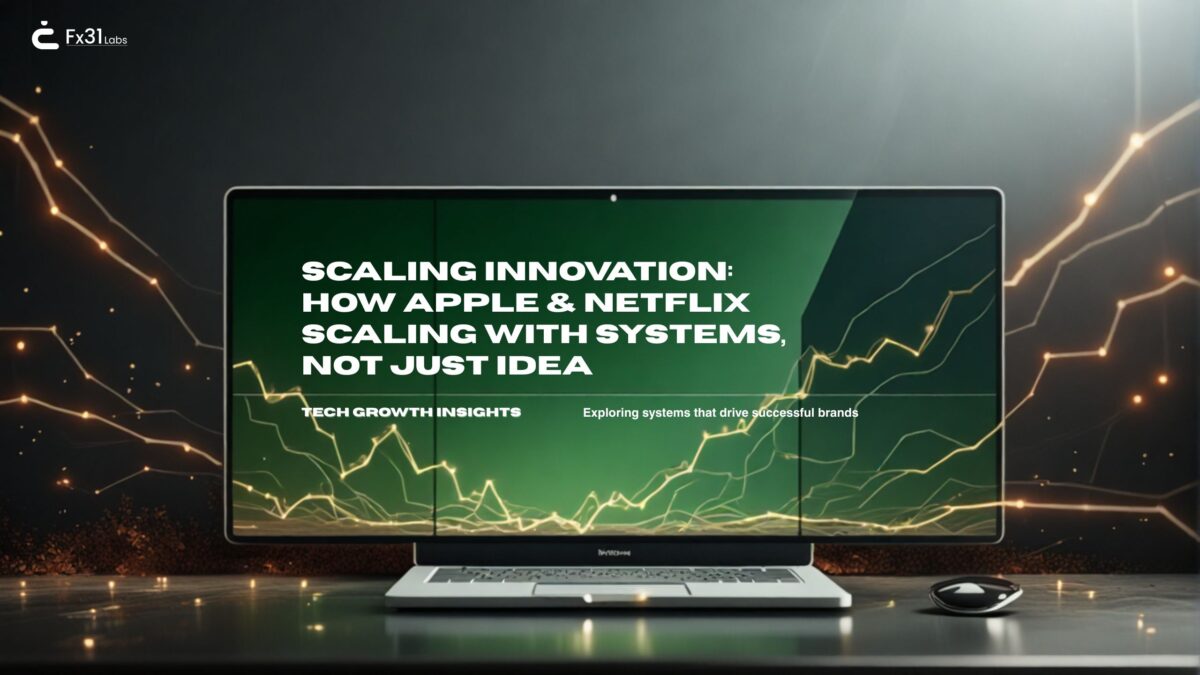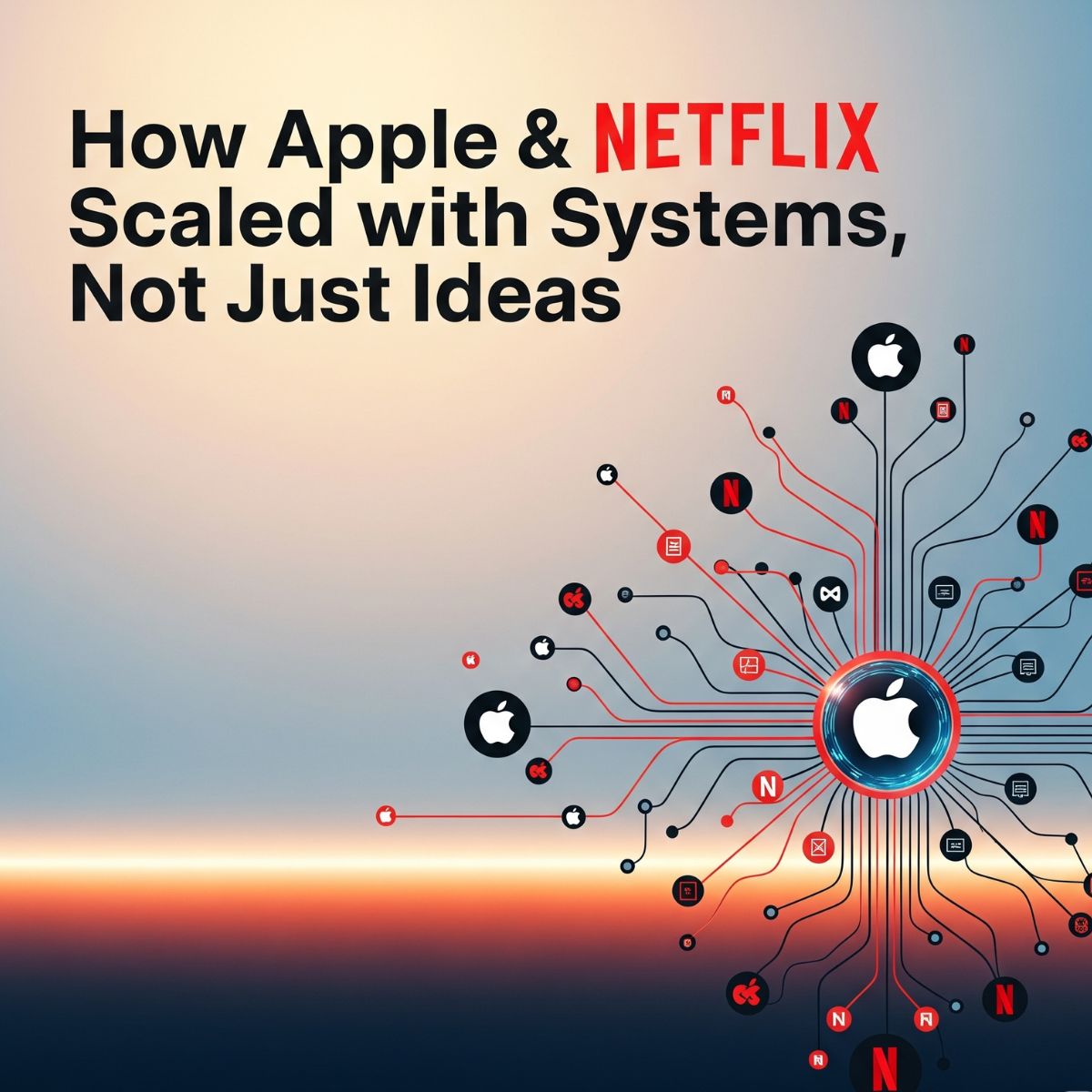How Apple & Netflix Scaled with Systems—Not Just Ideas | FX31 Labs

I. Introduction: Scaled with Systems—Not Just Great Ideas
Scaled with systems—that’s the hidden playbook behind Apple and Netflix’s global dominance. While the world celebrates their innovation and creativity, what truly powered their rise wasn’t just the brilliance of their ideas. It was the strength and repeatability of the systems they built around those ideas.
Think about it: The internet is full of smart ideas. Countless startups launch with disruptive visions, flashy MVPs, and bold mission statements. But only a select few reach massive scale, sustain growth over decades, and reinvent industries in the process.
What separates them?
Companies like Apple and Netflix didn’t rely on creativity alone. They designed systems—for product development, team culture, technology, feedback loops, and operations—that turned early wins into long-term dominance. They scaled not by accident or raw effort, but by intentional architecture.
In this blog, we’ll explore how Apple and Netflix scaled with systems, not just ideas. You’ll learn:
- The product and ecosystem strategies that powered Apple’s dominance
- The culture and tech stack systems behind Netflix’s evolution
- Why most startups fail to scale—and how to avoid those mistakes
- Practical lessons for founders looking to build enduring, scalable businesses
By the end, you’ll see why systems thinking—not just ideation—is the true growth engine for world-class tech companies.
II. The Myth of the ‘Eureka’ Idea
There’s a romantic notion in startup culture that every unicorn begins with a singular, dazzling idea—the “Eureka!” moment that rewrites the rules of the game.
But here’s the truth: Ideas are just the starting point. The harder, often invisible part is execution. And great execution doesn’t come from hustle alone—it comes from systems.
Steve Jobs famously said,
“To me, ideas are worth nothing unless executed. They are just a multiplier. Execution is worth millions.”
Similarly, Reed Hastings, co-founder of Netflix, emphasized that their success came from constant iteration, data-driven decision-making, and operational agility, not just a big bet on streaming.
Let’s take an example from early-stage startups. Many founders in India or Southeast Asia may identify a local market inefficiency—say, logistics, fintech onboarding, or digital healthcare delivery. But without systems for hiring, product delivery, QA, growth experimentation, and customer feedback, those insights don’t compound.
Scaling with systems means:
- Building repeatable product cycles, not one-time releases.
- Creating feedback mechanisms that drive improvement.
- Structuring team processes that survive founder dependency.
And most importantly—it means building architecture that scales when your users, team, and product complexity grow 10x.
Now, let’s see how Apple used this philosophy to dominate globally—not through a single brilliant idea, but through a web of systems.
III. How Apple Scaled Through Product Systems

Apple is often admired for its design, innovation, and marketing prowess. But beneath the surface lies an incredibly disciplined system of product and operational strategy—one that has enabled them to release hit after hit for over two decades.
A. The Ecosystem Strategy
One of Apple’s core systems thinking principles is its product ecosystem. Starting with the Mac, then the iPod, followed by the iPhone, iPad, and finally the Apple Watch and iCloud—Apple built a suite of products that work better together.
Each device was not just a standalone product—it was a node in a network:
- Your iPhone syncs effortlessly with your MacBook.
- Your AirPods pair instantly across devices.
- iCloud allows seamless access to files and photos, regardless of platform.
This ecosystem approach created:
- Network effects across hardware and software.
- High switching costs, increasing user retention.
- A system of upsells and cross-device engagement.
Rather than launching products in isolation, Apple designed them to complement and reinforce each other—turning ownership into a long-term user lifecycle system.
B. Vertical Integration
Unlike most tech firms that outsource hardware or software components, Apple built a system of vertical integration. From designing its own chips (A-series and M-series silicon) to controlling manufacturing partnerships and building proprietary software (macOS, iOS), Apple owns every part of the stack.
This allowed:
- Faster innovation cycles
- Consistent performance optimization
- Better control over security, privacy, and user experience
By bringing design, development, and manufacturing under one roof, Apple created a system of independence—which translated into a strategic moat.
C. Productization Process: NPI
Apple doesn’t just release products—it follows a rigorous New Product Introduction (NPI) system. This structured process involves:
- Idea screening and internal concept development
- Cross-functional collaboration between hardware, software, and operations
- Iterative prototyping, extensive user testing, and phased rollouts
This system ensures that every product—no matter how bold—goes through a predictable, quality-controlled pipeline.It also creates internal alignment: marketing, design, supply chain, and engineering are never out of sync.
✅ Key Takeaway:
Apple didn’t become the world’s most valuable company because it launched a “cool phone.” It succeeded because it scaled with systems—in product design, delivery, and user engagement—that allowed it to:
– Launch with consistency
– Scale with confidence
– Innovate without chaos
IV. How Netflix Scaled Through Operational and Cultural Systems
Netflix is often recognized for its early bet on streaming. But what truly set it apart wasn’t just foresight—it was its ability to build systems that could scale content delivery, engineering operations, and organizational decision-making in a volatile, fast-changing industry.
Let’s break that down.
A. Tech Stack Evolution: From DVDs to Cloud-Native
Netflix began as a DVD-by-mail service. But even before streaming went mainstream, they invested heavily in cloud infrastructure and global distribution systems.
Their strategic migration to AWS in 2008 laid the groundwork for scalability:
- It allowed them to serve millions of concurrent users across geographies.
- They adopted a microservices architecture, enabling modular development.
- Netflix’s engineers could deploy code thousands of times per day—an unmatched velocity at the time.
To complement this, they built Open Connect, a proprietary content delivery network (CDN) that positioned Netflix’s data closer to users around the world. This reduced latency, lowered costs, and ensured high-quality viewing.
👉 Lesson: Netflix didn’t just pivot. It engineered the pivot with robust systems designed to scale.
B. Data-Driven Personalization & Feedback Loops
Netflix’s recommendation engine is not just a feature—it’s a system that powers:
- User retention
- Content strategy
- Product iteration
They built a feedback loop where every user action—clicks, watch times, drop-offs—feeds into models that improve personalization. This system allowed:
- Curated homepages tailored to individual tastes
- Better forecasting of what content to greenlight (think House of Cards)
- Real-time experimentation with UI, pricing, and engagement features
This wasn’t one model—it was a culture of experimentation underpinned by data infrastructure.
👉 Lesson: Great product intuition is powerful. But scalable personalization comes from engineered systems that learn from behavior and close the loop.
C. Culture as an Operating System
Perhaps Netflix’s most iconic system is its culture.
The famous Netflix Culture Deck (now viewed millions of times) wasn’t just philosophy—it was a codified operating system for talent:
- Freedom with responsibility: Employees had autonomy—but were accountable.
- Talent density: Only hire and retain top performers.
- Context over control: Leaders provide clarity, not micromanagement.
This enabled decentralized decision-making and scalable innovation—without bureaucracy.
When COVID-19 hit, Netflix’s content operations were disrupted—but its distributed team structure and adaptive culture enabled quick pivots to remote production, animation, and licensing strategies.
👉 Lesson: Culture isn’t a vibe. It’s a scalable system for decision-making
Key Takeaway:
Netflix scaled by building systems across:
- Technology (cloud-native, microservices, Open Connect)
- Data (feedback loops, experimentation)
- Culture (values codified as systems)
While other media companies floundered with digital transformation, Netflix thrived because it scaled with systems—resilient, self-evolving systems built for long-term adaptability.
Link to: Netflix on AWS Case Study – Amazon
V. Why Startups Fail to Scale: Lack of Systems
Now, let’s contrast that with common startup struggles.
A great idea or early traction is exciting. But here’s where many startups—especially in growing markets like India, Southeast Asia, and Africa—hit roadblocks:
Common Symptoms:
- Ad hoc decisions: No framework for prioritization.
- Single point of failure: Everything runs through the founder.
- Shipping chaos: No standardized product delivery lifecycle.
- Tech debt: Fast code written without future-proofing.
- Team misalignment: No shared goals, unclear accountability.
- No feedback systems: No structured way to learn from customers or data.
These aren’t strategy failures. They’re system failures. Startups that survive and thrive don’t necessarily work harder—they work through repeatable structures that reduce friction as they grow.
VI. How Apple & Netflix Scaled with Systems: Lessons for founders
If you’re a founder or product leader looking to scale, the lessons from Apple and Netflix aren’t just for billion-dollar companies. The principles apply even at 5 people, 50 users, or 500 downloads—because they scaled with systems, not shortcuts.
Here’s how to build systems that scale with you:
A. Build a Repeatable Product Delivery System
Create a documented product development lifecycle:
- Use agile sprints (but don’t over-process early).
- Define roles and rituals (e.g., daily standups, retros).
- Maintain a product backlog and prioritize ruthlessly.
This reduces chaos and ensures clarity—especially with remote or hybrid teams.
B. Invest Early in Scalable Architecture
You don’t need hyperscale architecture from Day 1, but:
- Choose modular codebases (e.g., microservices, clean APIs).
- Set up CI/CD pipelines to automate testing and deployment.
- Use observability tools (like LogRocket, Datadog, or Sentry).
This avoids costly rewrites when your product catches fire.
C. Create People & Process Systems
Don’t wing it with hiring or team scaling:
- Use scorecards to define what great talent looks like.
- Build onboarding playbooks.
- Set up 30/60/90-day plans and feedback cadences.
This ensures culture scales, not just headcount.
D. Think in Feedback Loops
Embed learning into your startup DNA:
- Run lightweight user interviews.
- Track engagement metrics.
- Use data to inform—not override—intuition.
The faster your system learns, the faster your product improves.
E. System > Hero
Many founders rely on heroism: a genius engineer, a visionary PM, or late-night grinds. But those don’t scale.
Instead:
- Make quality a function of the process, not the person.
- Optimize for clarity, documentation, and automation.
- Use tools like Notion, Linear, Slack integrations to build workflows.
👉 Pro Tip: A startup that runs on systems doesn’t burn out its people—it amplifies them.
VII. How FX31 Labs Helps Founders Build Scalable Systems
At FX31 Labs, we partner with founders and teams who are ready to go beyond MVPs. We help you build repeatable, scalable systems—across product, tech, and growth.
Here’s how:
- MVP to Production: We help build scalable, modular architectures that evolve as your product grows.
- Agile Delivery: We implement sprint cadences, CI/CD, testing, and DevOps automation.
- Data & AI Systems: From analytics pipelines to AI assistants, we help you automate decision-making.
- Team Enablement: We co-create playbooks, tools, and tech culture that last beyond the founding team.
Whether you’re an early-stage startup in India, a scaling SaaS company in the US, or a product team in the Middle East, we bring systemic thinking to your journey.
VIII. Conclusion: The Hidden Architecture Behind Every Unicorn
The companies that dominate their industries don’t do it with just one brilliant product or pitch. They win because they build systems that:
- Deliver consistent value
- Grow without friction
- Adapt to market shifts
Apple scaled by designing a product and operations ecosystem. Netflix scaled by engineering its culture, feedback loops, and cloud-native platform.
Your startup can do the same. But don’t wait until you’re at 1 million users to start building systems. Start when you have 100.
Because scale isn’t a switch. It’s a system.
📌 Ready to scale with systems, not just ideas?
Let’s co-build your tech foundation, one sprint at a time.
👉 Talk to our team → fx31labs.com/contact
Would you like me to now package this as a formatted Google Doc or Notion-ready file for publishing and internal editing?
